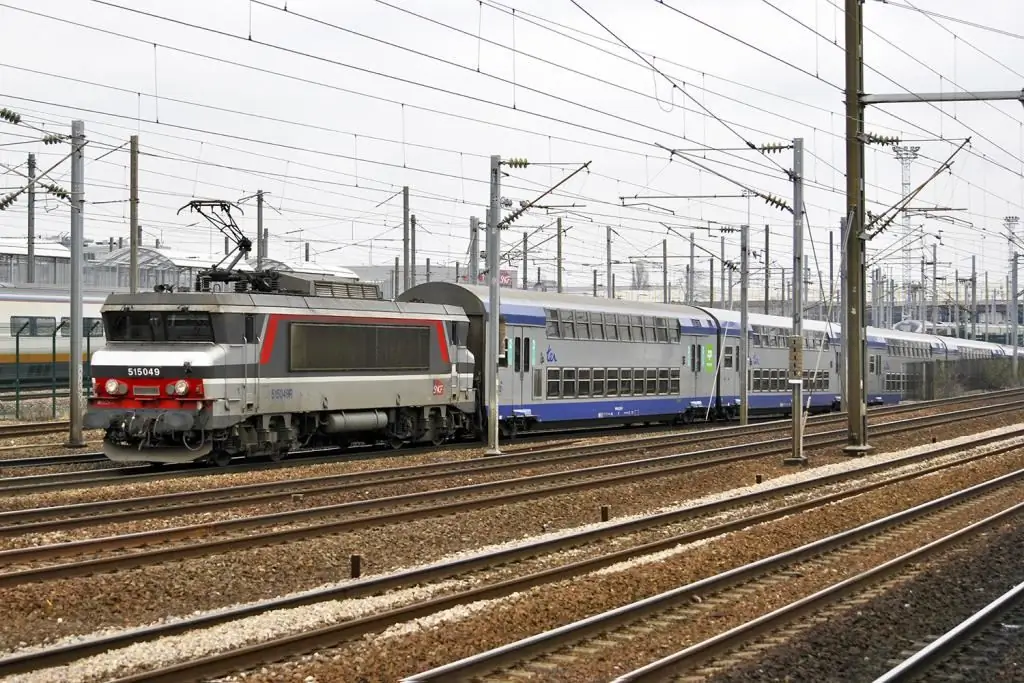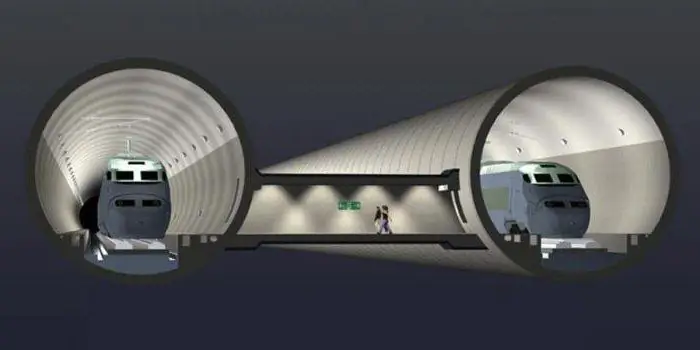2026 Author: Howard Calhoun | [email protected]. Last modified: 2025-06-01 07:12:56
More than two hundred years have passed since the moment when mankind invented the first steam locomotives. However, ground rail transport transporting passengers and heavy loads using the power of electricity and diesel fuel is still very common.
It is worth saying that all these years, engineers and inventors have been actively working to create alternative ways of moving. The result of their work was trains on magnetic cushions.
History of Appearance
The very idea of creating trains on magnetic cushions was actively developed at the beginning of the twentieth century. However, it was not possible to realize this project at that time for a number of reasons. The manufacture of such a train began only in 1969. It was then that a magnetic track began to be laid on the territory of the Federal Republic of Germany, along which a new vehicle was to pass, which was later called the maglev train. It was launched in 1971. The first maglev train, called Transrapid-02, passed along the magnetic track.

An interesting fact is that German engineers made an alternative vehicle based on the records left by the scientist Hermann Kemper, who received a patent confirming the invention of the magnetic plane back in 1934.
"Transrapid-02" can hardly be called very fast. He could move at a maximum speed of 90 kilometers per hour. Its capacity was also low - only four people.
In 1979, a more advanced maglev model was created. This train, called "Transrapid-05", could already carry sixty-eight passengers. He moved along the line located in the city of Hamburg, the length of which was 908 meters. The maximum speed that this train developed was seventy-five kilometers per hour.
In the same 1979, another maglev model was released in Japan. She was called "ML-500". The Japanese train on a magnetic cushion developed a speed of up to five hundred and seventeen kilometers per hour.
Competitiveness
The speed that magnetic cushion trains can develop can be compared to the speed of airplanes. In this regard, this type of transport can become a serious competitor to those air routes that operate at a distance of up to a thousand kilometers. The widespread use of maglevs is hindered by the fact that they cannot move on traditional railway surfaces. Trains on magnetic cushions need to build special highways. And this requires a large investment of capital. It is also believed that the magnetic field created for maglevs can negatively affectthe human body, which will adversely affect the he alth of the driver and residents of regions located near such a route.
Working principle
Magnetic cushion trains are a special kind of transport. During movement, the maglev seems to hover over the railroad tracks without touching it. This is due to the fact that the vehicle is controlled by the force of an artificially created magnetic field. During the movement of the maglev, there is no friction. The braking force is aerodynamic drag.

How does it work? Each of us knows about the basic properties of magnets from sixth grade physics lessons. If two magnets are brought together with their north poles, they will repel each other. A so-called magnetic cushion is created. When connecting different poles, the magnets will be attracted to each other. This rather simple principle underlies the movement of the maglev train, which literally glides through the air at an insignificant distance from the rails.
Currently, two technologies have already been developed, with the help of which a magnetic cushion or suspension is activated. The third is experimental and only exists on paper.
Electromagnetic suspension
This technology is called EMS. It is based on the strength of the electromagnetic field, which changes over time. It causes levitation (rise in the air) of the maglev. For the movement of the train in this case, T-shaped rails are required, which are made ofconductor (usually made of metal). In this way, the operation of the system is similar to a conventional railway. However, in the train, instead of wheel pairs, support and guide magnets are installed. They are placed parallel to the ferromagnetic stators located along the edge of the T-shaped web.

The main disadvantage of EMS technology is the need to control the distance between the stator and the magnets. And this despite the fact that it depends on many factors, including the unstable nature of the electromagnetic interaction. In order to avoid a sudden stop of the train, special batteries are installed on it. They are able to recharge the linear generators built into the support magnets, and thus maintain the levitation process for a long time.
EMS-based trains are braked by a low-acceleration synchronous linear motor. It is represented by supporting magnets, as well as the roadway, over which the maglev hovers. The speed and thrust of the composition can be controlled by changing the frequency and strength of the generated alternating current. To slow down, just change the direction of the magnetic waves.
Electrodynamic suspension
There is a technology in which the movement of the maglev occurs when two fields interact. One of them is created in the highway canvas, and the second one is created on board the train. This technology is called EDS. On its basis, a Japanese maglev train JR-Maglev was built.

This system has some differences from EMS, whereordinary magnets, to which electric current is supplied from the coils only when power is applied.
EDS technology implies a constant supply of electricity. This occurs even if the power supply is turned off. Cryogenic cooling is installed in the coils of such a system, which saves significant amounts of electricity.
Advantages and disadvantages of EDS technology
The positive side of a system running on an electrodynamic suspension is its stability. Even a slight reduction or increase in the distance between the magnets and the canvas is regulated by the forces of repulsion and attraction. This allows the system to be in an un altered state. With this technology, there is no need to install control electronics. There is no need for devices to adjust the distance between the web and the magnets.
EDS technology has some drawbacks. Thus, the force sufficient to levitate the composition can only arise at high speed. That is why maglevs are equipped with wheels. They provide their movement at speeds up to one hundred kilometers per hour. Another disadvantage of this technology is the frictional force generated at the back and front of the repulsive magnets at low speeds.
Due to the strong magnetic field in the section intended for passengers, it is necessary to install special protection. Otherwise, a person with a pacemaker is not allowed to travel. Protection is also needed for magnetic storage media (credit cards and HDD).
Developedtechnology
The third system, which currently exists only on paper, is the use of permanent magnets in the EDS variant, which do not require energy to be activated. Until recently, it was believed that this was impossible. The researchers believed that permanent magnets did not have such a force that could cause the train to levitate. However, this problem was avoided. To solve it, the magnets were placed in the Halbach array. Such an arrangement leads to the creation of a magnetic field not under the array, but above it. This helps to maintain the levitation of the train even at a speed of about five kilometers per hour.

This project has not yet received practical implementation. This is due to the high cost of arrays made of permanent magnets.
Dignity of maglevs
The most attractive side of maglev trains is the prospect of achieving high speeds that will allow maglevs to compete even with jet aircraft in the future. This type of transport is quite economical in terms of electricity consumption. The costs for its operation are also low. This becomes possible due to the absence of friction. The low noise of maglevs is also pleasing, which will have a positive impact on the environmental situation.
Flaws
The downside of maglevs is that it takes too much to make them. Expenses for track maintenance are also high. In addition, the considered mode of transport requires a complex system of tracks and ultra-precisedevices that control the distance between the canvas and the magnets.
Project implementation in Berlin
In the capital of Germany in the 1980s, the opening of the first maglev system called the M-Bahn took place. The length of the canvas was 1.6 km. A maglev train ran between three metro stations on weekends. Travel for passengers was free. After the fall of the Berlin Wall, the population of the city almost doubled. It required the creation of transport networks with the ability to provide high passenger traffic. That is why in 1991 the magnetic canvas was dismantled, and the construction of the subway began in its place.
Birmingham
In this German city, a low-speed maglev connected from 1984 to 1995. airport and railway station. The length of the magnetic path was only 600 m.

The road worked for ten years and was closed due to numerous complaints from passengers about the existing inconvenience. Subsequently, the monorail replaced the maglev in this section.
Shanghai
The first magnetic road in Berlin was built by the German company Transrapid. The failure of the project did not deter the developers. They continued their research and received an order from the Chinese government, which decided to build a maglev track in the country. This high-speed (up to 450 km/h) route connected Shanghai and Pudong Airport. The 30 km long road was opened in 2002. Future plans include its extension to 175 km.
Japan
This country hosted an exhibition in 2005Expo-2005. By its opening, a magnetic track 9 km long was put into operation. There are nine stations on the line. Maglev serves the area adjacent to the exhibition venue.

Maglevs are considered the transport of the future. Already in 2025, it is planned to open a new superhighway in a country like Japan. The maglev train will carry passengers from Tokyo to one of the districts of the central part of the island. Its speed will be 500 km/h. The project will need about forty-five billion dollars.
Russia
The creation of a high-speed train is also planned by Russian Railways. By 2030, maglev in Russia will connect Moscow and Vladivostok. Passengers will overcome the path of 9300 km in 20 hours. The speed of the maglev train will reach five hundred kilometers per hour.
Recommended:
Russian trains: elite RZD trains

Under the clatter of the wheels of a train rushing into the distance, one dreams in a special way, and dreams seem more interesting. Russian trains have long established themselves as a convenient, popular and affordable type of domestic public transport. As for branded and high-speed trains, they are considered the pride, the elite of Russian Railways. Riding in them is comfortable and pleasant, they are serviced according to the highest class: the cars are clean, the air conditioners are working, the bed linen is almost new
Regulations for negotiations during shunting work. Instructions for the movement of trains and shunting work

The current regulation of negotiations during shunting work replaced the outdated regulation (of 1999) and was put into effect by order of the Minister of Railways of September 26, 2003 Morozov
Vacuum train: principle of operation, testing. Train of the future

To increase the speed of any vehicle, it is necessary to suppress the friction force as much as possible. This is how spaceships fly into space, which can travel in space for a very long time without resistance. This same feature is at the heart of the project known as the "vacuum train"
Work permit for work in electrical installations. Rules for work in electrical installations. Work permit

From August 2014, Law No. 328n comes into force. In accordance with it, a new edition of the "Rules on labor protection during the operation of electrical installations" is being introduced
The train is public transport. Informative information about electric trains

The article provides basic information about suburban electric trains: what they are, how they differ from long-distance trains, how they work and for whom they are intended

